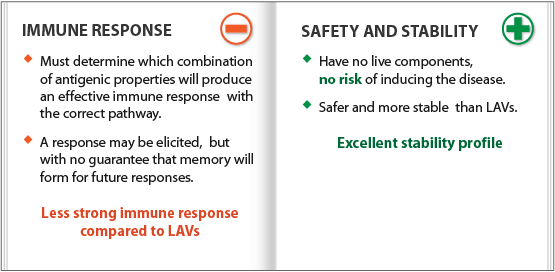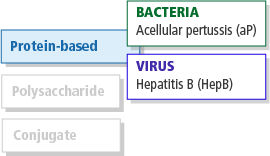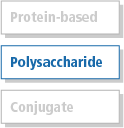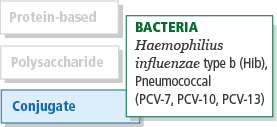Subunit vaccines

Immune response
- Subunit vaccines, like inactivated whole-cell vaccines do not contain live components of the pathogen. They differ from inactivated whole-cell vaccines, by containing only the antigenic parts of the pathogen. These parts are necessary to elicit a protective immune response.
- This precision comes at a cost, as antigenic properties of the various potential subunits of a pathogen must be examined in detail to determine which particular combinations will produce an effective immune response within the correct pathway.
- Often a response can be elicited, but there is no guarantee that immunological memory will be formed in the correct manner.
Safety and stability
Like inactivated vaccines, subunit vaccines do not contain live components and are considered as very safe.
Key point
Rather than introducing a whole-cell vaccine (either inactivated or attenuated) to an immune system, a subunit vaccine contains a fragment of the pathogen and elicits an appropriate immune response.

Subunit vaccines can be further categorized into:

Protein based subunit vaccines present an antigen to the immune system without viral particles, using a specific, isolated protein of the pathogen. A weakness of this technique is that isolated proteins, if denatured, may bind to different antibodies than the protein of the pathogen.
Commonly used protein-based subunit vaccines are the following:
- Acellular pertussis (aP) vaccines contain inactivated pertussis toxin (protein) and may contain one or more other bacterial components. The pertussis toxin is detoxified either by treatment with a chemical or by using molecular genetic techniques.
- Hepatitis B vaccines are composed of the hepatitis B virus surface antigen (HBsAg), a protein produced by hepatitis B virus. Earlier vaccine products were produced using purified plasma of infected individuals. This production method has been replaced by recombinant technology that can produce HBsAg without requiring human plasma increasing the safety of the vaccine by excluding the risk from potential contamination of human plasma.
The table lists the rare, more severe adverse reactions of these vaccines. Note the frequency of the adverse reactions to get an idea of how low or high the possibility of an adverse event is. Also read the Comments to understand additional context details on the adverse events.
Adverse reactions associated with subunit protein-based vaccines
| Vaccine | Rare, more severe adverse reactions | Comment | |
|---|---|---|---|
 |
Acellular pertussis (aP)30 | Same as tetanus and diphtheria toxoid vaccines. | Acellular pertussis-containing vaccines are less reactogenic in terms of mild-to-moderate reactions than wP-containing vaccines. See Pertussis vaccine example. |
 |
Hepatitis B (HepB)63 | Very rare | Reports of severe anaphylactic reactions are very rare. |

Some bacteria when infecting humans are often protected by a polysaccharide (sugar) capsule that helps the organism evade the human defense systems especially in infants and young children.
Polysaccharide vaccines create a response against the molecules in the pathogen's capsule. These molecules are small, and often not very immunogenic. As a consequence they tend to
- Not be effective in infants and young children (under 18–24 months),
- Induce only short-term immunity (slow immune response, slow rise of antibody levels, no immune memory).
Examples of polysaccharide vaccines include Meningococcal disease caused by Neisseria meningitidis groups A, C, W135 and Y, as well as Pneumococcal disease.

Conjugate subunit vaccines also create a response against the molecules in the pathogen's capsule. In comparison to plain polysaccharide vaccines, they benefit from a technology that binds the polysaccharide to a carrier protein that can induce a long-term protective response even in infants.
Various protein carriers are used for conjugation, including diphtheria and tetanus toxoid. Conjugate subunit vaccines, can therefore prevent common bacterial infections for which plain polysaccharide vaccines are either ineffective in those most at risk (infants) or provide only short-term protection (everyone else).
The advent of conjugate subunit vaccines heralded a new age for immunization against diseases caused by encapsulated organisms such as meningococcus, Haemophilus influenzae type b (Hib) and pneumococcus.
WHO recommends that children receive Haemophilus influenzae type b (Hib) and pneumococcal conjugate vaccines. In addition, the meningococcal A vaccine introduced in Africa is also a conjugated subunit vaccine.
Adverse reactions associated with conjugate vaccines
| Vaccine | Rare, more severe adverse reactions | Comment | |
|---|---|---|---|
 |
Haemophilus influenzae type b conjugate (Hib)65 | None known | Hib vaccine has not been associated with any rare, more severe adverse reactions. |
| Pneumococcal conjugate, 7-valent 10-valent (PCV-10), 13-valent (PCV-13)66 |
None known | PCV conjugate vaccines have not been associated with any rare, more severe adverse reactions. As with the introduction of any new vaccine, continued surveillance for possible unexpected effects is important. |
Key point
Conjugate vaccines can prevent common bacterial infections for which plain polysaccharide vaccines are either ineffective in those most at risk (infants) or provide only short-term protection (everyone else).
Question
Which of the following statements is incorrect:
| A. Polysacharide vaccines provoke an immune response against the polysaccharide capsule. | |
| B. Conjugate vaccine binds the polysaccharide to a carrier protein. | |
| C. Polysacharide vaccines are targeted, but not very immunogenic. They induce only short-term immunity. Polysacharide vaccines do not provoke a sufficient immune response in infants and young children but can in adults. | |
| D. Measles vaccine is a typical example for a Conjugate vaccine that provides better protection for infants compared to a Polysaccharide vaccine. | |
| E. Conjugate vaccine is effective in those most at risk (infants) and provides longer term protection (everyone else). |
Answer D is incorrect.
- Measles vaccine is a live vaccine, not a conjugate vaccine.

